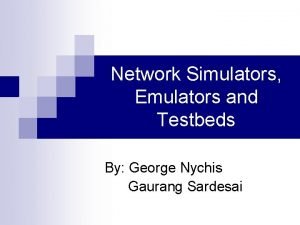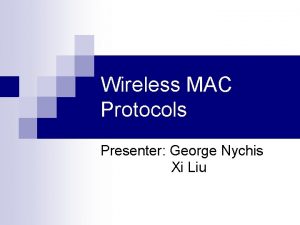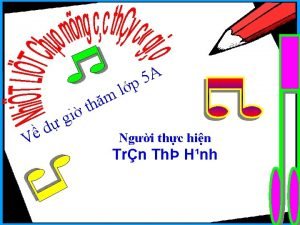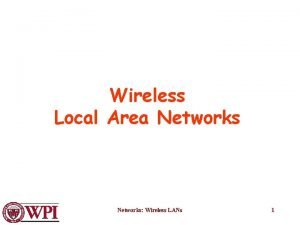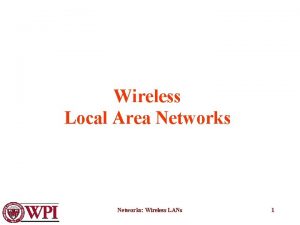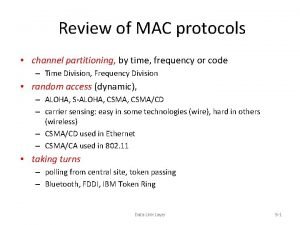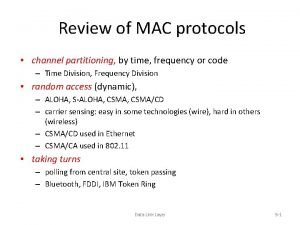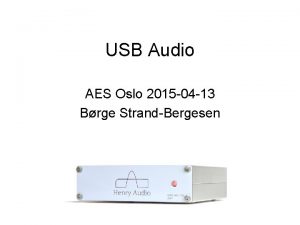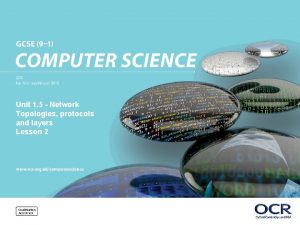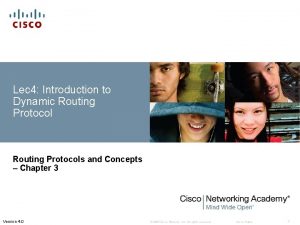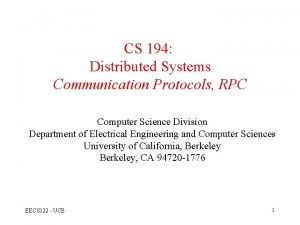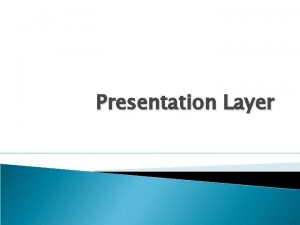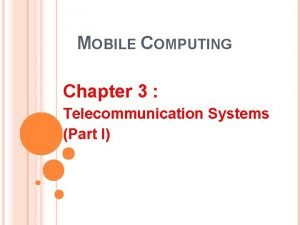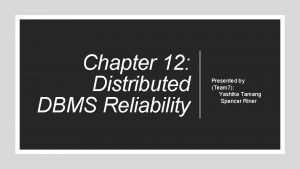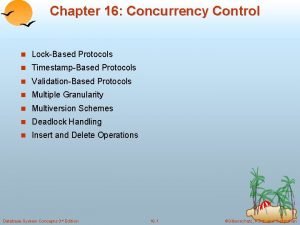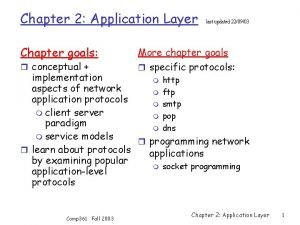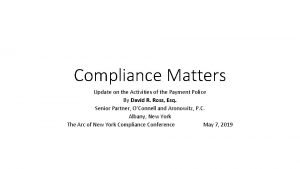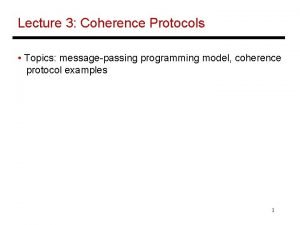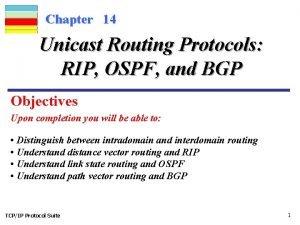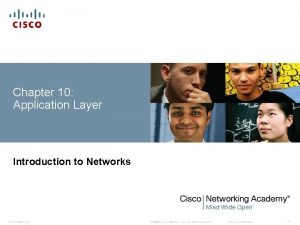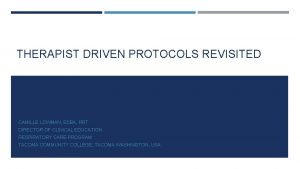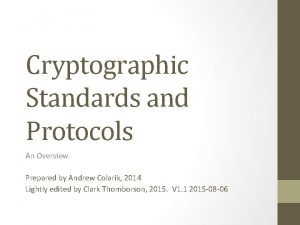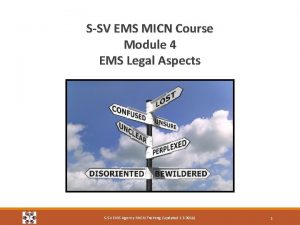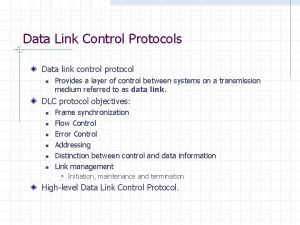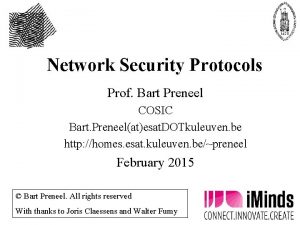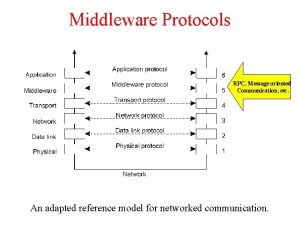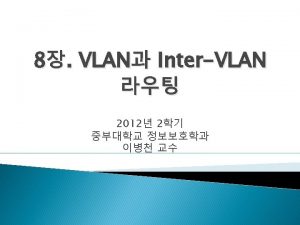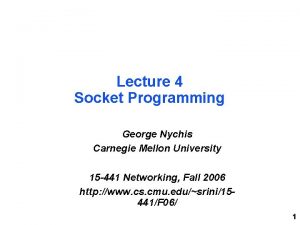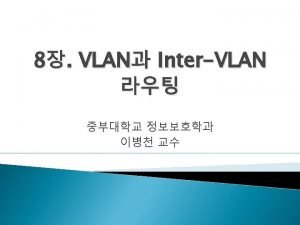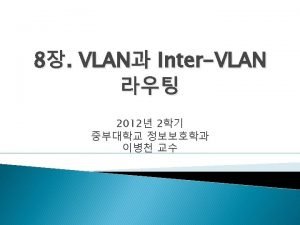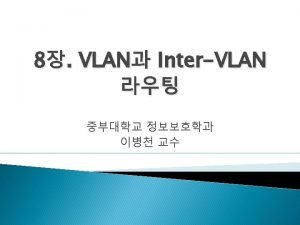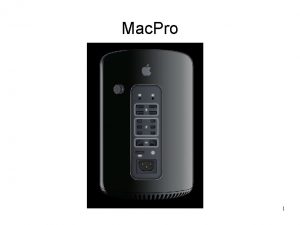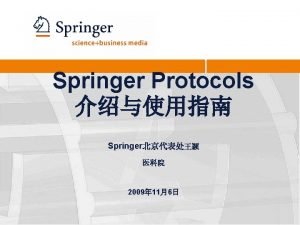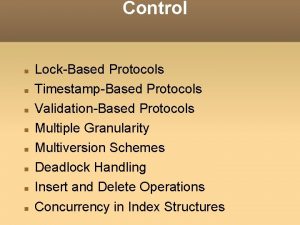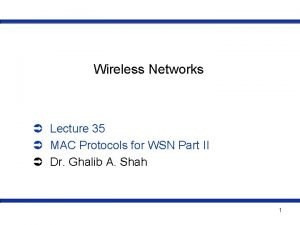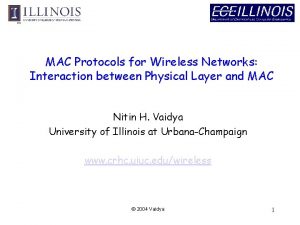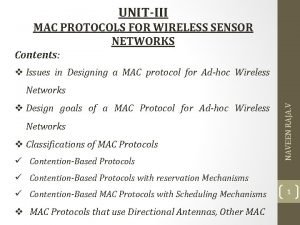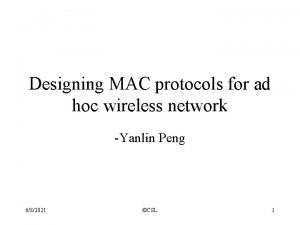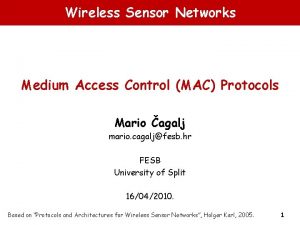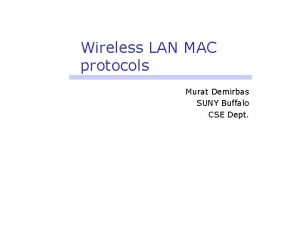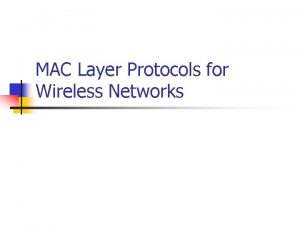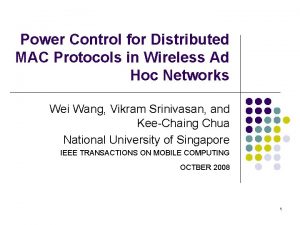Wireless MAC Protocols Presenter George Nychis Xi Liu











































![References n [E. 1] Phil Karn, "MACA - A New Channel Access Method for References n [E. 1] Phil Karn, "MACA - A New Channel Access Method for](https://slidetodoc.com/presentation_image/10ccfcfb0b4ba42202e10eba572d635d/image-44.jpg)


- Slides: 46

Wireless MAC Protocols Presenter: George Nychis Xi Liu

Outline Carrier Sense n MACAW n MACA-BI n Idle Sense n OAR n ECHOS n Carrier Sense MACAW MACA-BI Idle Sense OAR Echos

Carrier Sense n Basic Idea: listen before you send to avoid collisions n Why? ¨ Avoid wasted transmissions on collision ¨ Avoid corruption of other transmission Carrier Sense MACAW MACA-BI Idle Sense OAR Echos

Carrier Sense Design n General Components: ¨ Automatic Gain Control (AGC) system ¨ Baseband processor n ρ = Instantaneous signal strength Carrier Sense MACAW MACA-BI Idle Sense OAR Echos

How to Detect Transmissions 1. 2. 3. 4. Preamble Detection AGC unlock indicator Energy Detect De-correlation amplitude Carrier Sense MACAW MACA-BI Idle Sense OAR Echos

Can CS be improved? n n Exposed Terminal Hidden Terminal Carrier Sense MACAW MACA-BI Idle Sense OAR Echos

Carrier Sense Experiments n 60 -node wireless sensor network testbed ¨ Crossbow Mica 2 ¨ Radio @ 433 MHz & 48. 4 Kbps n What should we expected? Carrier Sense MACAW MACA-BI Idle Sense OAR Echos

Carrier Sense Experiment Results Carrier Sense MACAW MACA-BI Idle Sense OAR Echos

Do we always need it? n Oblivious to capture effect n Performs poorly with high load n Nodes that sent above the diagonal ρ = σ achieved higher throughput Carrier Sense MACAW MACA-BI Idle Sense OAR Echos

MACA n Addresses hidden terminal and exposed terminal problems n How? ¨ Throw away carrier sense! ¨ Use RTS / CTS Carrier Sense MACAW MACA-BI Idle Sense OAR Echos

Collisions in MACA Preferably, small RTS packet collides n Still chance of data collision n Can we reduce this? n ¨ Automatic Power Control n Include “S-meter” in CTS n Reduce RTS power n Don’t want to reduce CTS power n Need extra hardware Carrier Sense MACAW MACA-BI Idle Sense OAR Echos

MACAW n 4 design details 1. 2. 3. 4. Carrier Sense Contention is at the receiver Congestion is location dependent Fairness through learning of congestion levels Propagate synchronization information about contention periods MACAW MACA-BI Idle Sense OAR Echos

Fairness in MACAW n Channel capture in MACA ¨ Backoff doubled every collision ¨ Reduce backoff on success n Solution: Copy backoffs Carrier Sense MACAW MACA-BI Idle Sense OAR Echos

MACAW: Copying Backoffs n This does not always work as wanted Carrier Sense MACAW MACA-BI Idle Sense OAR Echos

MACAW: Additional Design n Multiple Stream Model n ACK Carrier Sense MACAW MACA-BI Idle Sense OAR Echos

MACAW: Additional Design n DS ¨ Because carrier sense disabled RTS CTS DS DATA Hears RTS Doesn’t hear CTS Hears DS Carrier Sense MACAW MACA-BI Idle Sense OAR Echos

RRTS n Problem: ACK RRTS Backoff Increases Cannot send CTS RRTS prevents P 2 from responding CTS X RTS DS DATA RTS CTS RTS lost Carrier Sense MACAW RTS DATA RTS DS MACA-BI Idle Sense OAR Echos

MACAW: Conclusions 8% extra overhead for DS and ACK n 37% improvement in congestion n n Future work: ¨ Multicast support ¨ Copying backoff Carrier Sense MACAW MACA-BI Idle Sense OAR Echos

MACA-BI Simplified version of MACA n MACAW: Increased MACA’s overhead n ¨ Increased 3 -way to 5 -way handshake n +Turnaround time n +Preamble Bits n +Control Bits ¨ Turnaround time has more effect with higher channel speeds Carrier Sense MACAW MACA-BI Idle Sense OAR Echos

MACA-BI Design Eliminate RTS n Replace CTS with RTR (Ready to Receive) n Carrier Sense MACAW MACA-BI Idle Sense OAR Echos

MACA-BI: Benefits Reduced turnaround time n Keeps MACA functionality n Data collision free just like MACA n Less vulnerable to control packet corruption (half as many control packets) n Receiver driven allows traffic regulation n Carrier Sense MACAW MACA-BI Idle Sense OAR Echos

MACA-BI: Data Collision Free 2. C is transmitting to D, and B transmits an RTR to A 3. C is receiving an RTR from D when B sends an RTR to A 1. C transmits a data packet to B Carrier Sense MACAW MACA-BI Idle Sense OAR Echos

MACA-BI: Results Minimal hidden terminal, CSMA Hidden terminal problems, which has less overhead is contention at the receiver Carrier Sense MACAW MACA-BI Idle Sense OAR Echos

Idle Sense - Problems of 802. 11 DCF n Short-term unfairness ¨ colliding hosts will be penalized No ACK != collision n Slow hosts limits the throughput of fast hosts n capture leads to long-term unfairness n Carrier Sense MACAW MACA-BI Idle Sense OAR Echos

Idle Sense – Basic Idea n Make hosts use similar Contention Window (CW) ¨ instead of exponential backoff ¨ Better fairness n Adapting CW to varying traffic conditions ¨ Hosts observe the number of idle slots between two transmission attempts ¨ Intuitively, this is an indicator of how many hosts are currently contending ¨ Adjust CW to an optimal value accordingly ¨ All hosts converge to a similar CW Carrier Sense MACAW MACA-BI Idle Sense OAR Echos

Idle Sense - Analysis Result Carrier Sense MACAW MACA-BI Idle Sense OAR Echos

Idle Sense - Principles n If we know N, things are much easier ¨ estimating N is undesired n Pick a fixed target nitarget for all cases ¨ Hosts observe ni ¨ If ni < nitarget , then CW <- CW + ε ¨ If ni > nitarget , then CW <- CW / α ¨ AIMD has the converging property Carrier Sense MACAW MACA-BI Idle Sense OAR Echos

Idle Sense - Properties n Decouple contention control with frame loss ¨ Solves the capture effect problem ¨ No exponential backoff due to bad channel quality ¨ Rate adaptation protocol n Similar CW ¨ short-term fairness n Time fairness ¨ Scaling CW according to transmission rate n Fully distributed ¨ and no information exchange Carrier Sense MACAW MACA-BI Idle Sense OAR Echos

Idle Sense - Throughput Carrier Sense MACAW MACA-BI Idle Sense OAR Echos

Idle Sense - Fairness Carrier Sense MACAW MACA-BI Idle Sense OAR Echos

Idle Sense - Convergence Speed Carrier Sense MACAW MACA-BI Idle Sense OAR Echos

Idle Sense - Time Fairness Carrier Sense MACAW MACA-BI Idle Sense OAR Echos

Rate Adaptation Protocols n Auto Rate Fallback (ARF): ¨ senders attempt to use higher transmission rate after consecutive successes ¨ revert to lower rate after failures n Receiver Based Auto Rate (RBAR): ¨ receiver measures channel quality ¨ piggyback in CTS ¨ sender decide transmission rate according to this information n Idle Sense Carrier Sense MACAW MACA-BI Idle Sense OAR Echos

Opportunistic Auto Rate (OAR) n Observation: ¨ Coherence time (duration where hosts have better channel quality) is at least several packet time n Idea ¨ If the channel is of high quality, user can transmit multiple packets ¨ Temporal fairness vs. throughput fairness Carrier Sense MACAW MACA-BI Idle Sense OAR Echos

OAR - Implementation Issues n How to estimate channel condition ¨ Use ARF, RBAR, Idle Sense n How to transmit several packet ¨ Utilize 802. 11 fragmentation ¨ set more fragments bit ¨ clear fragment number subfield Carrier Sense MACAW MACA-BI Idle Sense OAR Echos

OAR - Benefits Channel is better utilized, then better throughput n No RTS/CTS for subsequent packets n Reduce contention time per packet n Time fairness n Carrier Sense MACAW MACA-BI Idle Sense OAR Echos

ECHOS (Enhance Capacity 802. 11 Hotspots) n AP-CST: Access Point (modifies) Carrier Sense Threshold ¨ multiple flows can co-exist by dynamically modifying the carrier sense threshold n RNC-SC: Radio Network Controller (uses) Secondary Channels ¨ centralized algorithm that assigns hosts to cells/channels and adjust transmission power Carrier Sense MACAW MACA-BI Idle Sense OAR Echos

ECHOS - Three Ranges in Wireless n Obtained from Qual. Net ¨ Rate = 2 Mbps ¨ CST = -93 d. Bm ¨ Power = 15 d. Bm ¨ Pr = k. Pt / d 4 n n n transmission range interference range carrier sense range Carrier Sense MACAW MACA-BI Idle Sense OAR Echos

ECHOS - Example n n n Node 5 & 7 can hear only each other Node 3 & 9 can hear only each other Node 1 hear all transmissions Carrier Sense MACAW MACA-BI Idle Sense OAR Echos

ECHOS - Observations 1 n The use of physical carrier sensing with default fixed carrier sensing threshold (CST) can unnecessarily couple together several flows reducing per-flow and aggregate throughput Carrier Sense MACAW MACA-BI Idle Sense OAR Echos

ECHOS - Observation 2 n The optimum value of CST is that which the carrier sense range of the transmitter just covers the interference range of the receiver Carrier Sense MACAW MACA-BI Idle Sense OAR Echos

ECHOS - AP-CST n Basic idea: choose the appropriate CST to be used by each AP and stations ¨ Reducing CST may allow several flows to operate together without interference ¨ n Stations Given the signal strength of a station at AP, CST of a station is set to maximum signal strength that can be ignored while attempting to transmit, ¨ Then it is adjusted so that it can hear other stations from inside its own cell – avoid hidden terminal ¨ n AP ¨ Minimum SNR of the AP at its clients decides the CST of AP Carrier Sense MACAW MACA-BI Idle Sense OAR Echos

ECHOS - RNC-SC n Measure and determine if a cell is overloaded ¨ MAC service time: time between frame is submitted and ACK is acknowledged ¨ average over all users n Choose client and secondary channel ¨ Only when secondary AP and client can operate at low transmit power Carrier Sense MACAW MACA-BI Idle Sense OAR Echos
![References n E 1 Phil Karn MACA A New Channel Access Method for References n [E. 1] Phil Karn, "MACA - A New Channel Access Method for](https://slidetodoc.com/presentation_image/10ccfcfb0b4ba42202e10eba572d635d/image-44.jpg)
References n [E. 1] Phil Karn, "MACA - A New Channel Access Method for Packet Radio", 1990. n [E. 2] V. Bharghavan, A. Demers, S. Shenker , and L. Zhang. MACAW: A Media Access Protocol for Wireless LANs , In Proc. ACM SIGCOMM , London, U. K. , September 1994, pp. 212 -225. n [E. 3] B. Sadeghi, V. Kanodia, A. Sabharwal, and E. Knightly, Opportunistic Media Access for Multirate Ad Hoc Networks, in Proceedings of ACM MOBICOM 2002. n [E. 5] Martin Heusse, Franck Rousseau, Romaric Guillier, and Andrzej Duda. Idle Sense: An Optimal Access Method for High Throughput and Fairness in Rate Diverse Wireless LANs In Proc. of ACM SIGCOMM, Aug. 2005 n [E. 6] A. Vasan, R. Ramjee, and T. Woo. Echos - Enhanced Capacity 802. 11 Hotspots In Proc. of IEEE Infocom'05, Mar 2005 n [E. 7] F. Talucci, M. Gerla, and L. Fratta. MACA-BI (MACA by invitation) a receiver oriented access protocol for wireless multihop networks. In Proceedings of IEEE PIMRC, 1997. 630970 n [E. 8] Kyle Jamieson, Bret Hull, Allen K. Miu, Hari Balakrishnan. Understanding the Real-World Performance of Carrier Sense. ACM SIGCOMM Workshop on Experimental Approaches to Wireless Network Design and Analysis (E-WIND)

Q & A n Thanks!

Questions n Why hasn’t MAC changed much?
 George nychis
George nychis George nychis
George nychis Alex liu cecilia liu
Alex liu cecilia liu Líu líu lo lo ta ca hát say sưa
Líu líu lo lo ta ca hát say sưa Wireless lan protocols
Wireless lan protocols Wireless lan protocols
Wireless lan protocols Wireless sensor network protocols
Wireless sensor network protocols Channel partitioning mac protocols
Channel partitioning mac protocols Channel partitioning mac protocols
Channel partitioning mac protocols Telecommunications, the internet, and wireless technology
Telecommunications, the internet, and wireless technology Sources of macbeth
Sources of macbeth Mac mac o kok dac
Mac mac o kok dac George washington vs king george iii
George washington vs king george iii Venn diagram george washington and king george iii
Venn diagram george washington and king george iii Ssv ems protocols
Ssv ems protocols 5 network topologies
5 network topologies Introduction to dynamic routing protocols
Introduction to dynamic routing protocols Communication protocols for rpc
Communication protocols for rpc Tools and materials in making electrical gadgets
Tools and materials in making electrical gadgets Vermont ems protocols
Vermont ems protocols Presentation layer design issues
Presentation layer design issues Gsm mainly focuses on voice-oriented------ services.
Gsm mainly focuses on voice-oriented------ services. Remsa protocols
Remsa protocols Plc
Plc Orange county medical director
Orange county medical director Network communication protocols map
Network communication protocols map Local reliability protocols in dbms
Local reliability protocols in dbms Presentation layer protocols
Presentation layer protocols What are two pitfalls (problems) of lock-based protocols
What are two pitfalls (problems) of lock-based protocols Lab 4-1: routing concepts and protocols
Lab 4-1: routing concepts and protocols Application layer protocols
Application layer protocols Omig audit protocols
Omig audit protocols Cache coherence protocols
Cache coherence protocols Wan data link protocols
Wan data link protocols Remsa protocols
Remsa protocols Write a detailed note on unicast routing protocols
Write a detailed note on unicast routing protocols Application layer protocols
Application layer protocols Gateway protocols
Gateway protocols Clinical assessment protocols
Clinical assessment protocols Therapist driven protocols
Therapist driven protocols Igmpv
Igmpv Cryptography standards and protocols
Cryptography standards and protocols Ssvems
Ssvems Data link control protocols in computer networks
Data link control protocols in computer networks Network security protocols
Network security protocols Rpc message format
Rpc message format Dicom network protocol
Dicom network protocol
